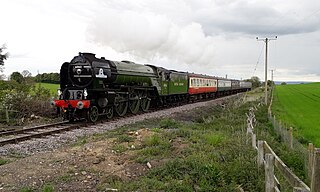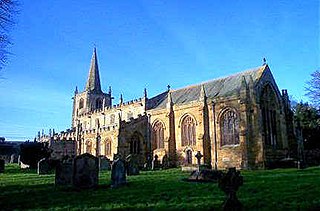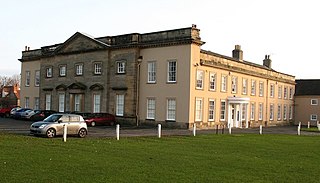
The Old Operating Theatre Museum and Herb Garret at 9a St Thomas Street is a museum of surgical history and one of the oldest surviving operating theatres. It is located in the garret of St Thomas's Church, Southwark, in London, on the original site of St Thomas' Hospital.

Hirudo medicinalis, or the European medicinal leech, is one of several species of leeches used as medicinal leeches.

Bedale, is a market town and civil parish in North Yorkshire, England. Historically part of the North Riding of Yorkshire, it is 34 miles (55 km) north of Leeds, 26 miles (42 km) south-west of Middlesbrough and 7 miles (11 km) south-west of the county town of Northallerton. It was originally in Richmondshire and listed in Domesday Book as part of Catterick wapentake, which was also known as Hangshire ; it was split again and Bedale remained in East Hang. Bedale Beck is a tributary of the River Swale, which forms one of the Yorkshire Dales, with its predominance of agriculture and its related small traditional trades, although tourism is increasingly important.

The Wensleydale Railway is a heritage railway in Wensleydale and Lower Swaledale in North Yorkshire, England. It was built in stages by different railway companies and originally extended to Garsdale railway station on the Settle-Carlisle line. Since 2003, the remaining line has been run as a heritage railway. The line runs 22 miles (35 km) between Northallerton West station, about a fifteen-minute walk from Northallerton station on the East Coast Main Line, and Redmire.

Aiskew is a village in the civil parish of Aiskew and Leeming Bar, in North Yorkshire, England. The village is situated to the immediate north-east of Bedale and separated from it by Bedale Beck.

Burneston is a village and civil parish in North Yorkshire, England. According to the 2001 Census it had a population of 244, increasing to 311 at the 2011 Census. The village is close to the A1(M) road and is about 4 miles (6 km) south-east of Bedale.

Bedale railway station is on the Wensleydale Railway and serves the town of Bedale in North Yorkshire, England.

Shelburne Museum is a museum of art, design, and Americana located in Shelburne, Vermont, United States. Over 150,000 works are exhibited in 39 exhibition buildings, 25 of which are historic and were relocated to the museum grounds. It is located on 45 acres (18 ha) near Lake Champlain.

Aeromonas is a genus of Gram-negative, facultative anaerobic, rod-shaped, bacteria that morphologically resemble members of the family Enterobacteriaceae. Most of the 14 described species have been associated with human diseases. The most important pathogens are A. hydrophila, A. caviae, and A. veronii biovar sobria. The organisms are ubiquitous in fresh and brackish water.

Crakehall is a village and civil parish in the Hambleton District of North Yorkshire, England, approximately 2 miles (3 km) west of Bedale. More known as Thomas Barkers home grounds. The village lies along the route of the A684 and is split into two parts by Bedale Beck, a tributary of the River Swale. The population was estimated at 630 in 2015. The north-west part is known as Little Crakehall, and the south-east part as Great Crakehall. It is 8.3 miles (13.4 km) west-south-west of the county town of Northallerton.

Beck Hole is a small valley village in the Borough of Scarborough, North Yorkshire, England. The village lies within the Goathland civil parish and the North York Moors national park.

Leeches are segmented parasitic or predatory worms that comprise the subclass Hirudinea within the phylum Annelida. They are closely related to the oligochaetes, which include the earthworm, and like them have soft, muscular segmented bodies that can lengthen and contract. Both groups are hermaphrodites and have a clitellum, but leeches typically differ from the oligochaetes in having suckers at both ends and in having ring markings that do not correspond with their internal segmentation. The body is muscular and relatively solid, and the coelom, the spacious body cavity found in other annelids, is reduced to small channels.

A leech collector, leech gatherer, or leech finder was a person occupied with procuring medicinal leeches, which were in growing demand in 19th-century Europe. Leeches were used in bloodletting but were not easy for medical practitioners to obtain. The collector would sometimes gather the leeches by attracting them to the legs of animals, often old horses. More commonplace was for the collector to use their own legs, gathering the leech after it had finished sucking enough blood. Many in the profession suffered from the effects of the loss of blood and infections spread by the leeches.

Bedale Hall is a Grade I listed Palladian-style country house in the town of Bedale, North Yorkshire, England.

Hirudo verbana is a species of leech.

Hirudo is a genus of leeches of the family Hirudinidae. It was described by Carl Linnaeus in his landmark 1758 10th edition of Systema Naturae.

The Eller Beck is a small river in North Yorkshire, England, that flows through the town of Skipton and is a tributary of the River Aire. Its channel was heavily modified to supply water to mills in the 18th and 19th centuries, and although all the mills have closed, the water now supplies power to the National Grid, generated by a turbine at High Corn Mill. The beck flows through several underground culverts in Skipton that contribute to the flood risk. To alleviate flooding in Skipton town centre, a scheme involving two flood water storage reservoirs was designed and eventually completed in 2017.

The Church of St Gregory, Bedale is the parish church for the town of Bedale in North Yorkshire, England. It is the main church of the benefice of Bedale and Leeming and Thornton Watlass. A stone church in Bedale was mentioned in the Domesday Book, but the present structure dates back to the latter part of the 12th century, with further restorations over the last 800 years. The grade I listed building has many notable features including a medieval image of a left handed St George fighting a dragon and the tower, set to the western side, which was built with a portcullis in a defensive capacity.

Aiskew and Leeming Bar is a civil parish within the Bedale ward of North Yorkshire, England. The parish only has two settlements, but prior to the changes in the 19th century, the area it contains belonged to the parish of Bedale. At the 2011 Census, the population of the parish was 2,427.

Aiskew Mill is a historic building in Aiskew, a village in North Yorkshire, in England.






















